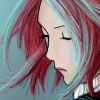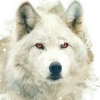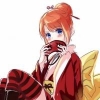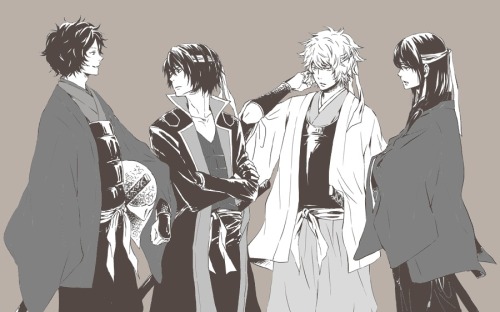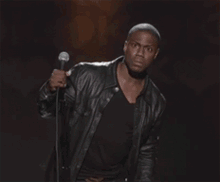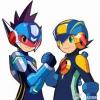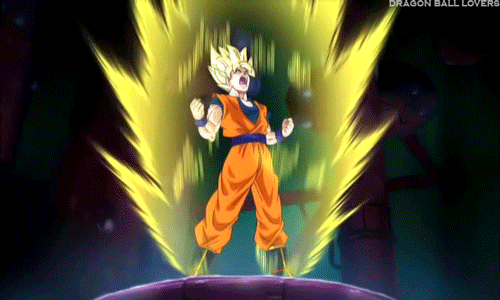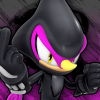Interview Part I
First, I’d like you to talk about Naruto’s geneses and tell us some anecdotes about it.
MK: At first, Naruto wasn’t a story about Ninja
Really?
MK: Yes, I wanted to write a story about a teenage boy that was cooking ramen and who was called Naruto. But my editorial chef from that time told me “That will never work” So I had to find something else and it became a story about ninjas.
After my gastronomical manga’s rejection, I made a one-shot about a ghost story in which Naruto was a fox boy that had the power to change other people’s appearance. To diversify this magic, I added the ninja art. At the end, from my first idea is only the name that is left.
Naruto’s name, does it really come from the surimi that we found in ramen?
MK: Yes, at that time, I was found of ramen. In front of my university was a restaurant called Ichiraku.
I didn’t knew Naruto’s favorite canteen really existed… Anyway, after several tries, you finally came to choose a story about ninja. Did you have an interest in that universe since long time ago?
MK: Not really, but I really liked Japanese themes or themes centered around a cultural aspect of Japan. At the time I was sending a lot of projects, I suggested a story about a samurai to the Jump. I had no prize and no positive response from it… But in my opinion, it was more because of the pape than the story itself (laugh).
We need an explanation to this.
MK: The paper shop didn’t have any manga paper B4 anymore, and the seller cut the paper herself for me. But apparently, she didn’t cut it on the right size.
Was it too small?
MK: No, too big.When I had to put the paper in the envelope, I realized it didn’t fit in (laugh). So, I had to make an envelope myself. To me, it looks like I really failed because the paper wasn’t at the right size.
Such a heartbreaking story…
MK: Well the truth is that I never got to know the real reasons to why it didn’t worked well. However, I didn’t give up on making a manga about a Japanese theme.
And giving that the samurai didn’t go well for me, I thought I could try a ninja theme. But at that time, there was already Ninku that had been published in the Jump. The circumstances were not good for suggesting another Ninja story. Ninku was already innovator by mixing ninja art and karate. Me, I had to find something new in that ninja world, and that was one hell of a challenge.
But that’s precisely this hard situation that motivated me. I knew it was the right time to choose a ninja theme among all the Japanese themes. So I decided to try my luck on this genre.
And it’s been 13 years that this manga is published.
MK: In whatever work I’m doing, before realizing it, I’m used to do a lot of researches at the library by reading other mangas working on the same theme etc.
That’s how I get a lot of ideas in my head. And also, I had a long preparation time.
Are you talking about the time passing between the approbation of the Jump and the actual release of the first chapter?
MK: Jump has 4 reunions by year, in which they choose the new publications. Usually, when they take a decision, the first chapter is published the next month.
But for an unknown reason, Naruto started at the same time as the mangas choose at the next reunion, the one that took place 3 months later.
Do you mean that you had a gap of 3 months between the decision they took and the publication of the first chapter?
MK: During that period, I modified several times the nemu, so much that at the time the first chapter was actually released I already had 8 chapters in nemu form. Thanks to that gap, I could work without being stressed and do a good job on the manga. Thinking about it, without this preparation time, the manga couldn’t have last this long.
Did you have the time to think about what is a ninja and about the characters?
MK: Yes, I had the chance to do so. My editorial chef gave me Kôga no ninpou chô and Iga ninpou chô, 2 masterpieces among story about ninja. I read Koga, but sadly, I didn’t finish it (laugh).
When you are creating a character, are you first choosing its name or his appearance?
MK: I’d say it’s 50/50. Sometimes I first draw it and then I create its personality and give it a name. And other times, on the contrary, I first establish how the character is, and from that, I give hit a name and an appearance.
Could you give me an example of case in which the visual aspect came to your mind first?
MK: Zabuza. I wanted to give him a name that would match with a scary man.
And on the contrary, for which character did you first established its name and its personality?
MK: Jiraya for example… From his name that is reminding about a kabuki theatre character, I created a sort of mage hermit that is holding in his mouth a parchment and that is lapping a giant frog. For Kimimaro too, I started with his name. I drew two black points on his forehead, like aristocrats people from Heian used to have. These kinds of characters were obviously created from their name.
In such cases, do you pay any particular attention to the impression theses characters give?
MK: Absolutely, Kimimaro was a name I heard on the TV, in a historical saga. I thought it sounded very Japanese, very traditional.
Do character’s names have any influence on their temper and their identity?
MK: Yes, Neji for example, he’s throwing swirls (Neji means “screw”), it makes you think about a rotation or about a swirl, which is very close to Uzumaki (“swirls”) Naruto. So I was very careful for it to not be too redundant.
Haku (“white”) has pale skin and a pure personality. I include a final scene with the snow falling down to add a reference to the whiteness implied in his name. And on the contrary, I started Kiba with his appearance, given that he’s always with his dog, I named him “Inuzuka” (“Inu” means “dos”).
The first character like Naruto Uzumaki and Kakashi Hatake had already a name and first name. What is the reason for the new characters like Gaara to not have a family name anymore?
MK: At first, Gaara was meant to be named Katarô Fûma, but my editorial chef disagreed. I protested against his rejection saying that it was a good name for someone coming from Suna. This disagreement last a long period.
Did his rejection come from the resemblance with Fûma no Kojiro, another manga?
MK: Even now, I don’t know the real reason (laugh). When I said “So, how am I suppose to name him?”he answered “Gaara”. “As an Ashura that is loving himself” He added. He looked so sure of himself that I said “Alright, it sounds good.” And I kept his suggestion.
Sometimes later he said to me that it was a ski station name… It was just the name of the place where he was recently gone. I thought it was so stupid, but since I liked the name, I kept it. After that, I stopped worrying about name and first name. I focused my work on the name’s evocations and the sonorities.
Which names were the most hard to find?
MK: It’s never easy for me to find character’s names, but it’s is for the first characters that it was the most hard to find. What was the most hard was to find a lot at the same time. During the chuunin exam, I had to find 10 names in one week. I didn’t knew what name choose anymore at the end. I don’t really remember, for example, for Neji, I must have thought about a screw. It tells you how much I wasn’t inspired.
More than a name itself, it’s the fact that I needed a lot of them at the same time that was my problem. This, I remember it very well. And I wanted to give some adjectives to every ninja of Kumo like Samui, or Darui. But what’s funny is that at one moment, I couldn’t find any valid name anymore, and it became such a drag.
Now let’s focus on the magic aspect. How does the jutsu that Naruto and the others use come to your mind? And how do you choose their name?
MK: During our reunions, I suggest a technique to my editorial chef and we think about it together. At first, I was explaining it to him with my sketches, because when we don’t see it in movement, it’s hard to understand it. And when we have decided what the attack will look like together, I choose its name.
And then again, it’s difficult. Usually I suggest names that are simple and clear like “kage bunshin”. Rarely satisfied with it, my editorial chef says “Don’t you have a cooler name?” So I search something better. For example, “Chidori” had a totally different name at first.
Can we know what it was?
MK: I forgot what it was. It tells you how much it was different (laugh). When I already have in mind an episode relating to the origins of the name, the rest comes easily to my mind. “In the past, there was a sword called Chidori, it had cut the thunder and was renamed Raikiri”. From there, I clearly saw a technique linked to the thunder in my head.
The more I talk with mu editorial chef, the more I modify the form of a jutsu. For the Chidori, I tended toward the form of a lot of birds which are singing. For edo tensei, I explained to my editorial chef that I needed a jutsu making the dead ones come back to life; he suggested the Buddhist name of Edo Tensei.
You were taking a lot of time to create the different jutsus, right?
MK: I was taking so much time for choosing the right name, that I came to think “What am I doing this? I could always do it more easily…” But now I realize that it Is what made up Naruto’s Universe.
When I heard the seiyuu pronouncing the technique’s names, I understand that it was much more impressive once it is shouted by the seiyuu. And still, I think the clarity is important.
Anyway, I have to find the good balance. We have to guess what the technique look like just by reading it. That’s how I create the different jutsu and all the attacks.
It’s obvious that these attacks are important to the universe of your work. Now, I’d like to talk about the dialogues. How does the “dattebayo” came to your mind?
MK: I was searching for an expression a little brat would say when he’s complaining. In fact, I started my researches with the famous “datteba!”
So, had you decided from the start, that Naruto would have a language tic?
MK: Yes, indeed. It may look a little too simplest to create a character, but I wanted it to be as clear as possible. I like when the manga characters have a catch phrase. This way, the reader can more easily remember this character.
And since I like when the reader is confused, maybe even irritated, O gave a weird catch phrase to Naruto.
(Next part in the Earth’s scroll)
Interview Part II
Now I’d like to ask you about the character’s way of talking. Let’s begin with Kakashi; at first he was rude in his way of talking, did he become nicer?
MK: In his conception, I made him talk like a samurai. At that time, I still hadn’t really figured out his personality.
Since I wanted him to be a master strict like in the old times, I made him talk in consequence of that. But at the end, I didn’t like it, so I thought it would be better to make Kakashi a professor a little dizzy.
And that’s how you created his actual personality?
A slacker professor looks funnier too me. However, once Kakashi is in action, he’s energetic. This contrast is what makes his charm.
I changes his way of talking by changing it several times. By making his sentences longer, I added some nonchalance and some kindness; maybe it even gives him some girlish aspect.
Outside of Naruto and Kakashi, there are other characters that are talking in a recognizable way. Is there some dialogue that is stick in your mind or that is hard for you to write?
MK: Hum… I’d say Orochimaru’s ones.
I wanted him to be baffling for the people who knew him because of his androgyny. But since, in parallel to that, I wanted him to be a powerful enemy; I wondered if it was this way of talking was the best to translate the strength he has in him. But in the end, I think I did well, it’s a good way to add some kind of scary aspect in him and that aspect grew up through the chapters.
As for Jiraya who looks like he’s coming from a kabuki theatre play, I choose since the beginning that he would have an energetic and incisive way of talking, which is reminding the reader of this kind of theatre way of talking. And since there are such a few numbers of grandiloquent characters, he’s adding some colors in the overall picture.
When you’re doing the dialogues, what are the points to which you pay any particular attention?
MK: I always try to distort it. Once I found a good phrase, I do my best to make it more hermetic, thank to this distortion work.
And what is this distortion work?
MK: First, in the nemu, I do a sketch that I then properly do. I modify some dialogues. At first, I write them in a simple way, it’s after that that everything is played. I try to transmit my originality, but it’s not easy.
What kind of modifications?
MK: I rewrite the dialogues to make them look more formal, maybe even weirder. But I usually go too far, and my assistants complain about not understanding what I’m writing. In this case, I retake the original phrase.
So you want the reader to be confused?
MK: Yes, I want to write outstanding dialogues, even if it’s not pleasant to read at first. Naruto is a ninja, but his outfit for example has nothing to do with the traditional ninjas.
How did you create such a particular universe?
MK: I decided since the beginning that I didn’t want to write a traditional representation of ninja wearing black outfits and living in the shadow, I didn’t want to make a manga that we have already seen so many times. I wanted the ninja to show himself and not hiding himself in the shadow. Well they are supposed to hide themselves, but the hero doesn’t do it. He’s showing himself in the light and gives his name…
Anyway, compared to the other ninjas, he loves being noticed. Also, his blond hair and blue eyes gives a foreign aspect to his appearance which is also unexpected for a ninja.
Indeed, that’s surprising…
MK: It’s the same for the setting.
I didn’t want the reader to know in which country the story was situated. And the ninjas are wearing jackets and other clothes with a zip…
Anyway, I gradually receded my story from the stereotypes. I just wanted the ninja to wear sandals to remind of the straw slippers from the past.
I noticed this international touch in this overall Japanese universe. But I never thought Naruto looks like a foreigner.
MK: Despite this, the manga is imprinted in a Japanese atmosphere. But this atmosphere mix past and present. We can find electric poles, but also bois roof that are typical of our traditional house.
At first, I drew a lot of typical Japanese objects like vending machines. But when I began to add cars in my one-shots, my editorial chef refused it and explained to me “they have to not be that comfortable”. The gun would make lost the shuriken what is interesting in them, so they also have been rejected. So gradually, I putted some non shocking objects in the Naruto Universe.
When I listen what you’re saying, I’m thinking about a Japan that is observed by foreigners.
MK: Yes, that’s what I had in mind since the beginning. In one of my favorite video game, Far East of Eden, the décor makes you think about the foreigners’ vision on Japan. This way of working has always caught my interest.
I also add some kabuki elements. In our modern world, we never see this kind of make-up or outfit. But it’s part of our tradition. I wanted to add this grandiose side that is very impactful on the panel in my mangas.
Nowadays, Naruto is a success in a lot of country. In your opinion, is it thanks to your concern about the foreign reader’s opinion on it?
MK: Indeed, I think it is part of it.
Your characters have simple names. Did you, here too, think about the foreigners?
MK: I choose the most easy to remember names. Even though, it’s not always easy to parody the name of a ninja from the past.
I, at least, look for names that sound Japanese like and that sound good, like Wasabi or Kakashi.
Was there a precise moment in which you began to think about non Japanese readers?
MK: Yes, when I was told that Naruto was becoming a success in other countries, I simplified the disposition of the panels, so it would be easier for the foreigners to read it. Thinking about a larger audience had a lot of consequences on the série.
In your opinion, what is the thing in Naruto that attracts the most the foreigners?
MK: The hero is far from being a genius. He starts from being a looser and is always rising himself higher gradually. This kind of story speaks to anyone, whatever is his nationality.
Another factor is: Ninjas are adored in the entire world.
Now, I’d like you to talk about “bound”, the main theme of this work… Among all the scenes of this manga in which you were focusing on this theme, are there some of them that is particularly stuck in your mind?
MK: I’d say Jiraya’s death. Thanks to a mysterious strength that we could call “will”, he finds the strength to deliver the secret to Naruto. I feel like I successes in transmitting his will to accomplish his duty as a master and the depth of the bound that is tying him to his disciple.
And still, these scenes, I make them spontaneously, despite the current rhythm of the manga. SO I rarely think “I was really good on this one!”
Since the beginning of the manga, did it happened that you once thought “That’s it, that’s the scene I wanted to do…” or “That’s the theme I wanted to focus on.”?
MK: I wanted to talk about acknowledgment. The one we give and the one we receive. At the end, that’s what I wanted to say, that’s what I wanted to do.
In your manga, you’re talking about how the characters gain their peers’ respect by fighting and learning.
Deep down, is it this need of acknowledgment that is making them act?
MK: Everyone needs to be acknowledged, I’m the first in that case.
This need was in me even before the release of the first chapters, and even now, I’m fighting to be acknowledged by my contemporary peoples. And the fact I wasn’t part of the admired ones in the past gives me more strength.
This feeling that I know very well, I’m still gonna describe it.
What kind of acknowledgment do you need?
MK: Back at school, I was a looser in sport and in my studies, and I wasn’t popular with my comrades.
I was always conscious of not being considered.
But if you choose to do a manga, you must be rather self-confidence…
MK: Yes, thanks to manga, that’s to say drawing, I hoped to be acknowledged by a lot of people, and being able to live from it.
Though, my editorial chef didn’t give me a lot of credit (laugh).
For a long time now, you’re fighting to do a manga that could give you acknowledgment.
MK: It’s very difficult to please every reader, but I had a strong need of acknowledgment. At first, my work couldn’t allow me to obtain it, but the lack of response was such as I was keeping on drawing in a contradictory spirit way.
There are several steps to gain acknowledgment, right? We first, published a one-shot, then it gives birth to a série and then we gain acknowledgment.
MK: During my first years, my several reunions with my editorial chef were happening first on the Shueisha’s rez-de-chaussée and then it moved to the redaction’s floor.
I was feeling the acknowledgment, but that’s when my one-shot passed to the WSJ that I felt like it was concretized.
Sadly, my one-shot was even lower ranked than the cover of the Jump itself. The reunions went back to the rez de chaussée. But it just reinforced my need of acknowledgment.
This important event in my life has a big link with Naruto.
Among the master and comrades that acknowledge Naruto, there are Iruka or Jiraya for example. What is an ideal master in your opinion?
MK: A benevolent master that is explaining clearly the right thing to do, instead of scolding his disciple. Anyway, a Kakashi like master. I really would have liked to have a master like him.
If I understand well what you’re saying, you weren’t inspired by someone you really knew?
MK: No, he’s the master I’m sad to not have had, someone that encourage his pupil rather than critic him.
You’re expressing mutual acknowledgment through bonds. Could you tell us more about it?
MK: There is no bond if mutual acknowledgment doesn’t exist.
Now, I’m talking about friendship, love between parents and child and all the things I know. Since I’m a father, I now, know a lot about this relationship.
When we’re talking about friends or rivals, the acknowledgment is made through fights. But when we’re talking about brotherhood or parenthood, bonds always exist. Does your representation of it vary depending on the type of relationship in question?
MK: Since the readers know the bond between parents and child, I don’t need to go too deep into it. Friendship may be harder to draw. And it’s the same for heart brother, the ones who don’t have any blood link. In Naruto, there are other bonds than family. What is the difference, if the father sees in the kid a son, or if the kid sees in the adult a father?
For example, I drew Iruka and Naruto as a father and son. In the second part, it’s less clear.
That’s true. Iruka was introduced as an adoptive father for Naruto.
MK: Being orphan at the beginning, I wanted Naruto to see Iruka as a father.
There is a chapter in which Sasuke says to Naruto that he sees him as a brother. Is it the way you were imagining their bond since the beginning?
MK: I wanted them to be even more brothers than true brothers. Sadly, I always had difficulties at writing this bond, and even now, it’s still hard for me to do so. People who endured separation or loneliness must understand me, but when I’m close to someone, I’m always afraid to lose my bond with this person. Loneliness scares me. It may be hard to transmit to the readers, but I’m still gonna try to express it.
So you think you still didn’t express the bond between Naruto and Sasuke well enough?
MK: Maybe I wasn’t good at expressing my feelings, and because of that they look like weirdo. But everything will depend on the way I will depict them in the future.
Are you talking about both Naruto and Sasuke?
MK: Yes, if you want, I can talk about their bond. I created Sasuke as a rival for Naruto, but a rival that didn’t want to acknowledge Naruto as a rival. I thought it would be interesting for Naruto to have by his side a guy that would disdain him. And while Naruto climbs always higher, it becomes more and more difficult for Sasuke to not acknowledge Naruto as a rival. But he leaves the village without having recognized his friend’s merits.
By assisting to Naruto’s evolution, Sasuke sees a competitive spirit toward the one he was snubbing growing inside him.
MK: After the battle at the Valley of the End, they see the gap between them growing up. But when someone that was about to acknowledge you reject you, your need to be acknowledged by this person becomes bigger. Sasuke still hasn’t recognized Naruto as his equal. I think, and I hope, Naruto will fight until Sasuke acknowledge him as his closest comrade.
In the manga, their fight will soon begin. We, readers, want to know if they’re gonna if they will be tied before the denouement.
MK: The story too is at its climax. But I’m still thinking about some plot twists. Don’t miss it.
That’s really exiting! To conclude, could you say something to your readers about this books?
MK: These 2 books contain a lot of scenes and a lot of dialogues. If there happen to be just one of them that could cheer you up, I’d be glad about it.
![]()
![]() .
. ![]()
![]()
![]() .
.![]()
![]() .
. 

